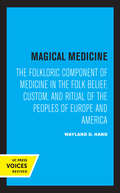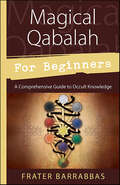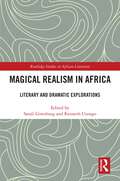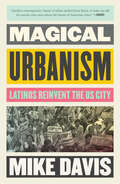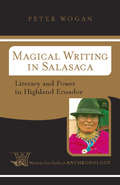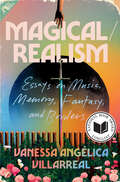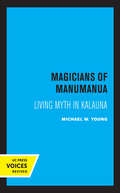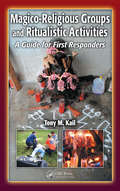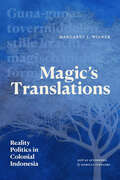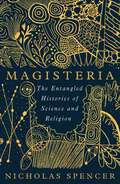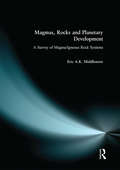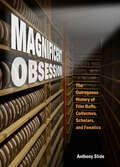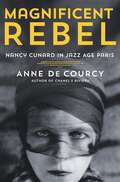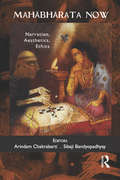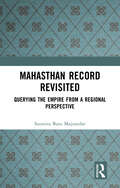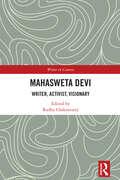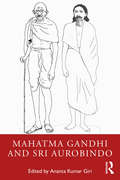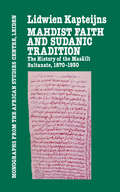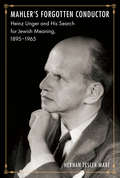- Table View
- List View
Magical Medicine: The Folkloric Component of Medicine in the Folk Belief, Custom, and Ritual of the Peoples of Europe and America
by Wayland D. Hand"Distilling baby's first tear into the eye of a blind man to make him see"; "Plucking herbs upward for emetics and downward for purgatives"; "Stroking one's goiter with a dead man's hand to make the growth shrivel away"--these are not beliefs and customs found among primitive peoples in remote parts of the world but are examples of hundreds of items of magical medicine found in Professor Hand's remarkable collection of essays dealing with this neglected field in twentieth-century Europe and America. Fantasy and imagination still have free reign in people's lives, more than any of us will admit. In a time when science is preeminent, irrational thinking ca lay hold on the mid of man as much as in olden times. Folk medicine has expanded in recent years to include holistic medicine and other forms of alternative medicine, but little attention has been paid to magical medicine. Despite the benefits of medical science in an advance culture, the magical medicine of Europe and America has clung to an unusually rich and original body of magical lore that lies at the base of its folk medical thought. Ethnomedicine in the inner cities of America can be better understood by practitioners who know something about folk medicine and, especially, if they kno some of the basics of magical medicine. This title is part of UC Press's Voices Revived program, which commemorates University of California Press's mission to seek out and cultivate the brightest minds and give them voice, reach, and impact. Drawing on a backlist dating to 1893, Voices Revived makes high-quality, peer-reviewed scholarship accessible once again using print-on-demand technology. This title was originally published in 1980.
Magical Qabalah for Beginners: A Comprehensive Guide to Occult Knowledge
by Frater BarrabbasDiscover the history and theory of Qabalah as well as its practical ritual uses. Explore the five basic but essential parts of Qabalah: the ten Sephiroth, the twenty-two paths, the Four Worlds, the Three Negative Veils, and the Tree of Life.The Qabalah is the symbolic key to the Western Mystery tradition. Gain invaluable insights into all occult systems including high magic, Tarot, astrology, alchemy, hermetics, and more. In Magical Qabalah for Beginners, Frater Barrabbas shows ritual magicians, Pagans, and occult students how to incorporate the Qabalah into practice, using tables of correspondences, numerology, acronyms and formulae, sigils and ciphers, contemplation, and the theurgy of ascension. Now is the time to penetrate the mystical properties of Qabalah and make them work in your life.Praise:"Frater Barrabbas has crafted a comprehensive overview of the Qabalah that is clear and accessible."—Chic and Tabatha Cicero, Chief Adepts of the Hermetic Order of the Golden Dawn and authors of The Essential Golden Dawn"Those starting out on the path of learning magical Qabalah would do well to explore this book."—Scott Stenwick, author of Arcana"Magical Qabalah for Beginners is the introductory book that I wish we'd had back when I was first being trained in the Craft."—Veronica Cummer, author of Sorgitzak: Old Forest Craft
Magical Realism in Africa: Literary and Dramatic Explorations (Routledge Studies in African Literature)
by Kenneth Usongo Sarali GintsburgMagical realism has deep roots across many African languages and regions. This book explores African magical realism from a transregional and inclusive approach, drawing on contributions from different literary genres across the continent.The chapters in this book constitute a sustained and insightful reflection on the salient components of this literary genre as well as evaluating its connections to themes of conflict, violence, women’s rights, trauma, oppression, culture, governance, and connecting to the African self. As well as theorizing magical realism, this book engages with African expressive performance across various formats, novels, plays, and films. This book investigates African magical realism from its origins up to the present day, where local oral traditions link indigenous cosmogonic stories with Western literature, as well as with the specific narrative traditions of Arabo‑Islamic literature. The rich analysis draws on works from across the continent, including Egypt, Sudan, Mauritania, Cameroon, Kenya, Tanzania, Angola, and Mozambique.This book is a timely contribution to debates within African literature, cultural anthropology, ethnography, and folklore.
Magical Urbanism: Latinos Reinvent the US City
by Mike DavisWinner of the 2001 Carey McWilliams AwardIs the capital of Latin America a small island at the mouth of the Hudson River? Will California soon hold the balance of power in Mexican national politics? Will Latinos reinvigorate the US labor movement?These are some of the provocative questions that Mike Davis explores in this fascinating account of the Latinization of the US urban landscape. As he forefully shows, this is a demographic and cultural revolution with extraordinary implications. With Spanish surnames increasing five times faster than the general population, salsa is becoming the predominant ethnic rhythm (and flavor) of contemporary city life. In Los Angeles, Houston, San Antonio, and (shortly) Dallas, Latinos outnumber non-Hispanic whites; in New York, San Diego and Phoenix they outnumber Blacks. According to the Bureau of the Census, Latinos will supply fully two-thirds of the nation&’s population growth between now and the middle of the 21st century when nearly 100 millions Americans will boast Latin American ancestry.Davis focuses on the great drama of how Latinos are attempting to translate their urban demographic ascendancy into effective social power. Pundits are now unanimous that Spanish-surname voters are the sleeping giant of US politics. Yet electoral mobilization alone is unlikely to redress the increasing income and opportunity gaps between urban Latinos and suburban non-Hispanic whites. Thus in Los Angeles and elsewhere, the militant struggles of Latino workers and students are reinventing the American left. Fully updated throughout, and with new chapters on the urban Southwest and the explodiing counter-migration of Anglos to Mexico, Magical Urbanism is essential reading for anyone who wants to grasp the future of urban AmericaThis paperback edition of Mike Davis&’s investigation into the Latinization of America incorporates the extraordinary findings of the 2000 Census as well as new chapters on the militarization of the border and violence against immigrants.
Magical Writing In Salasaca
by Peter WoganThis engaging case study of Salasaca, a village in highland Ecuador, examines indigenous beliefs about writing, such as Day of the Dead name lists, comparisons with weaving, and a witch who kills people listed in his book of names. Magical Writing in Salasaca demonstrates that these beliefs reflect extensive contact with birth certificates, baptism records, and other church and state documents. Wogan's inquiry into the place of literacy in the Salasacas' worldview provides a nuanced look at the power relations between elites and nonelite villagers, at the same time that it imparts an empathetic understanding of alternative ways of viewing ostensibly familiar aspects of the world. Magical Writing in Salasaca will appeal to anyone interested in anthropology, literacy, power, or Latin America.
Magical Writing in Salasaca: Literacy and Power in Highland Ecuador
by Peter WoganExplores the connections between beliefs about writing and power in an indigenous village in highland Ecuador.
Magical/Realism: Essays on Music, Memory, Fantasy, and Borders
by Vanessa Angélica VillarrealA brilliant, singular collection of essays that looks to music, fantasy, and pop culture—from Beyoncé to Game of Thrones—to excavate and reimagine what has been disappeared by migration and colonialism. Upon becoming a new mother, Vanessa Angélica Villarreal was called to Mexico to reconnect with her ancestors and recover her grandmother&’s story, only to return to the sudden loss of her marriage, home, and reality. In Magical/Realism, Villarreal crosses into the erasure of memory and self, fragmented by migration, borders, and colonial and intimate violence, reconstructing her story with pieces of American pop culture, and the music, video games, and fantasy that have helped her make sense of it all. The border between the real and imagined is a speculative space where we can remember, or re-world, what has been lost—and each chapter engages in this essential project of world-building. In one essay, Villarreal examines her own gender performativity through Nirvana and Selena; in another, she offers a radical but crucial racial reading of Jon Snow in Game of Thrones; and throughout the collection, she explores how fantasy can help us interpret and heal when grief feels insurmountable. She reflects on the moments of her life that are too painful to remember—her difficult adolescence, her role as the eldest daughter of Mexican immigrants, her divorce—and finds a way to archive her history and map her future(s) with the hope and joy of fantasy and magical thinking. Magical/Realism is a wise, tender, and essential collection that carves a path toward a new way of remembering and telling our stories—broadening our understanding of what memoir and cultural criticism can be.
Magicians of Manumanua: Living Myth in Kalauna
by Michael W. YoungThis title is part of UC Press's Voices Revived program, which commemorates University of California Press’s mission to seek out and cultivate the brightest minds and give them voice, reach, and impact. Drawing on a backlist dating to 1893, Voices Revived makes high-quality, peer-reviewed scholarship accessible once again using print-on-demand technology. This title was originally published in 1983.
Magickal Mystical Creatures: Invite Their Powers into Your Life
by D.J. ConwayGain the Magical Powers of More Than 200 Amazing CreaturesFrom pookas and green men to gorgons and gargoyles, this occult encyclopedia reveals everything you need to know about more than two hundred marvelous beasts. Magickal, Mystical Creatures invites you to explore their history, symbolism, appearance, associated traits, and abilities. Best of all, it shows you how their energies and talents empower your magickal workings, rituals, and meditations.Draw upon the knowledge of griffins and water-folk to eliminate barriers blocking your progress. Invoke the energy of the centaur for artistic inspiration. Work with the magickal serpent when you need a financial windfall. This comprehensive bestiary introduces you to a variety of incredible beings just waiting to enhance your life with their legendary wisdom and power.Previously published with ISBN 9781567181494.The Complete Magickal BestiaryLong ago, strange and fabulous beasts filled the tales of storytellers and the myths of many cultures. Over time, humankind abandoned its connection with these powerful helpers.This comprehensive guide describes the history, symbolism, appearance, associated traits, and magickal abilities of over two hundred magickal creatures, and tells how to enlist their aid:UnicornsCentaursSatyrs and FaunsGriffinsGoblinsMagickal SerpentsGigantic BirdsGargoylesGremlinsFabulous LionsThe RuhkMystical Bulls and Bull-MenTrollsPixiesDwarfsThe Riddling SphinxRed Cap Hell HoundsWater-FolkCreatures of the Stony StareThe SalamanderHuman-BirdsFox SpiritsFlying HorsesRemember the forgotten magick—rediscover the unique abilities and powerful influence of the marvelous beings in Magickal, Mystical Creatures.
Magico-Religious Groups and Ritualistic Activities: A Guide for First Responders
by Tony M. KailMore than just a litany of artifacts, rituals, and symbols, this valuable book provides a cultural bridge for emergency responders. It places the information in a relevant context and offers crucial keys to communication, assessment, and treatment in culturally sensitive situations. Beginning with the importance of trans-cultural communication, the book separates fact from fantasy regarding Neo-Paganism, Santeria, Bantu religion (Palo Mayombe), Voodoo, and Curanderismo. Promoting functional cultural competency, this book provides the tools to properly assess situations, open lines of communication, protect cultural diversity, and provide effective emergency treatment.
Magic’s Translations: Reality Politics in Colonial Indonesia
by Margaret J. Wiener“Do you believe in magic?” This familiar question suggests magic is easily recognized but unreal. In Magic’s Translations, Margaret J. Wiener argues that such views are shaped by historical power struggles, especially in Europe’s relations with the wider world. Focusing on nineteenth- and twentieth-century Dutch interactions with Indonesians, Wiener reveals how colonial agents framed unfamiliar practices, practitioners, and objects as “magic,” rendering distinct phenomena fundamentally alike and advancing colonizing projects that deemed magic antithetical to reason and reality. While colonial authorities, including ethnologists, mobilized the concept of magic to differentiate Europeans from Indonesians, nature from culture, reason from superstition, and fact from fetish, their efforts produced unexpected outcomes: Some Indonesian artifacts and acts not only retained their power but invaded European experiences. As anthropologists were among the key translators of magic throughout the world, Wiener intersperses accounts of magic’s translations in the Indies with reflections on anthropology’s ongoing engagement with the concept. She demonstrates that magic became an object of expert knowledge, political control, and popular fascination, rather than a self-evident category or relic of naïve belief.
Magisteria: The Entangled Histories of Science & Religion
by Nicholas SpencerMost things you &‘know&’ about science and religion are myths or half-truths that grew up in the last years of the nineteenth century and remain widespread today. The true history of science and religion is a human one. It&’s about the role of religion in inspiring, and strangling, science before the scientific revolution. It&’s about the sincere but eccentric faith and the quiet, creeping doubts of the most brilliant scientists in history – Galileo, Newton, Faraday, Darwin, Maxwell, Einstein. Above all it&’s about the question of what it means to be human and who gets to say – a question that is more urgent in the twenty-first century than ever before. From eighth-century Baghdad to the frontiers of AI today, via medieval Europe, nineteenth-century India and Soviet Russia, Magisteria sheds new light on this complex historical landscape. Rejecting the thesis that science and religion are inevitably at war, Nicholas Spencer illuminates a compelling and troubled relationship that has definitively shaped human history.
Magmas, Rocks and Planetary Development: A Survey of Magma/Igneous Rock Systems
by Eric A. MiddlemostThe variety of volcanic activity in the Solar System is widely recognised, yet the majestic sequences of magmatic processes that operate within an active planet are much less well known. Providing an exposition of igneous rocks, magmas and volcanic erupsions, this book brings together magnetic and volcanic data from different tectonic settings, and planets, with explanations of how they fit together. It systematically examines composition, origin and evolution of common igneous rocks, yet also examines a variety of rare magnetic rocks that play a crucial role in the global magma/igneous rock system.
Magnifeco: your head-to-toe guide to ethical fashion and non-toxic beauty
by Kate BlackIn the wake of the Rana Plaza factory collapse in Bangladesh-the worst garment industry accident in recorded history-the words . fashion disaster. acquired a new and much more sinister meaning.<P><P> Commentators suggested that the tragedy was completely predictable in a sector with a shocking track record of rampant environmental damage, the use of toxic chemicals, and chronic human rights abuse. Now the industry is undergoing a shift, and many of us are questioning our buying habits. The rise of socially and environmentally responsible retailers like Patagonia and The Body Shop has led to dramatic changes in the eco and ethical fashion landscape. Magnifeco is the Fast Food Nation of the fashion world-your guide to making a difference too. In this guide, author Kate Black: Examines non-toxic beauty and ethical fashion Recommends a multitude of ways for consumers to make better decisions Introduces the brands and designers leading the way along this socially responsible path. With this complete head-to toe guide covering everything from hair and beauty products to shoes and footwear, you can feel better about everything you put on your body and be-magnifeco!
Magnificent Obsession: The Outrageous History of Film Buffs, Collectors, Scholars, and Fanatics
by Anthony SlideIn Magnificent Obsession: The Outrageous History of Film Buffs, Collectors, Scholars, and Fanatics, author Anthony Slide looks at the way film has dominated the minds and lives of film buffs, film collectors, film academics, and just plain fans of past movies. Based on the author's more than fifty years in the field and his personal, up-front knowledge of the subject, chapters provide unique documentation on film buffs who once created a livelihood from their hobby, including long-forgotten Chaw Mank and the vast array of film clubs that he headed and New York radio and television sensation Joe Franklin. The history of fans and their fan clubs are discussed, as well as the first and only periodical, Films in Review, which catered both to film scholars and film buffs. The histories of several legendary film collectors such as David Bradley and Herb Graff are featured, as is Hollywood's Silent Movie Theatre, where film buffs found a home from the 1940s onwards, sharing it with drug dealers, male prostitutes, fantasists, and hit men.Magnificent Obsession is vast in its approach, discussing the entire history of the phenomenon of the film buff from the early 1910s through the present and documenting the manner in which film buffs have changed--thanks to the internet--from relatively gentle and kind individuals to the obsessive, sometimes overbearing, and often self-important film buffs of today.
Magnificent Rebel: Nancy Cunard in Jazz Age Paris
by Anne de CourcyAnne de Courcy, the author of Husband Hunters and Chanel's Riviera, examines the controversial life of legendary beauty, writer and rich girl Nancy Cunard during her thirteen years in Jazz-Age Paris.Paris in the 1920s was bursting with talent in the worlds of art, design and literature. The city was at the forefront of everything new and exciting; there was no censorship; life and love were there for the taking. At its center was the gorgeous, seductive English socialite Nancy Cunard, scion of the famous shipping line. Her lovers were legion, but this book focuses on five of the most significant and a lifelong friendship.Her affairs with acclaimed writers Ezra Pound, Aldous Huxley, Michael Arlen and Louis Aragon were passionate and tempestuous, as was her romance with black jazz pianist Henry Crowder. Her friendship with the famous Irish novelist George Moore, her mother’s lover and a man falsely rumored to be Nancy’s father, was the longest-lasting of her life. Cunard’s early years were ones of great wealth but also emotional deprivation. Her mother Lady Cunard, the American heiress Maud Alice Burke (who later changed her name to Emerald) became a reigning London hostess; Nancy, from an early age, was given to promiscuity and heavy drinking and preferred a life in the arts to one in the social sphere into which she had been born. Highly intelligent, a gifted poet and widely read, she founded a small press that published Samuel Beckett among others. A muse to many, she was also a courageous crusader against racism and fascism. She left Paris in 1933, at the end of its most glittering years and remained unafraid to live life on the edge until her death in 1965. Magnificent Rebel is a nuanced portrait of a complex woman, set against the backdrop of the City of Light during one of its most important and fascinating decades.
Mahabharata Now: Narration, Aesthetics, Ethics
by Arindam Chakrabarti Sibaji BandyopadhyayThe Mahabharata is at once an archive and a living text, a sourcebook complete by itself and an open text perennially under construction. Driving home this striking contemporary relevance of the famous Indian epic, Mahabharata Now focuses on the issues of narration, aesthetics and ethics, as also their interlinkages. The cross-disciplinary essays in the volume imaginatively re-interpret the ‘timeless’ classic in the light of the pre-modern Indian narrative styles, poetics, aesthetic codes, and moral puzzles; the Western theories on modern ethics, aesthetics, metaphysics, psychoanalysis, and philosophy of science; and the contemporary social, ethical and political concerns. The essays are all united in their effort to situate the Mahabharata in the context of here and now without violating the sanctity of the ‘written text’ as we have it today. The book will be of interest to scholars and students of Indian and comparative philosophy, Indian and comparative literature, cultural studies, and history.
Mahasthan Record Revisited: Querying the Empire from a Regional Perspective
by Susmita Basu MajumdarA small record consisting of six to seven lines that has been published by eminent epigraphists several times, would require a fresh interpretation was almost beyond imagination. It was by chance that the Indian Museum displayed the Mahasthan stone plaque, and after seeing this record, several questions arose which demanded a fresh interpretation, and this enquiry finally culminated into this slim monograph. The book attempts a re-reading of this inscription and also provides a fresh interpretation. It tries to situate this record in a broader canvas by interrogating the record along with several other evidences. This finally leads us to look at the Mauryan Empire from a regional perspective.
Mahasweta Devi in Defence of the Human: The Poetics of Translating Resistance
by Anuradha GhoshThis book re-thinks the literary and social worlds of Mahasweta Devi, the prolific and influential writer and social activist, in connection to her praxis. It brings into focus Devi’s preoccupation with the human, nature and life, and unwritten or distorted histories that underline her poetics of translating resistance in terms of a radical alterity.The defining feature of Devi’s writings is the position she adopts in defence of the human, questioning the nature of the ‘abject’ in her discourse on the oppressed. Essays in this volume focus on her subversive retellings from the Mahabharata, the political aspects of translation/adaptation of her works in literature, cinema and visual arts and comparative readings of her works by women authors from the Global South as well as the Indian diaspora. They examine her early publications, her writings for children, and the notion of aesthet(h)ics, i.e., ethics and/in aesthetics, as a gesture to pave forward a discourse on liberation and social justice that remains a challenge for the world.The book will be of significant interest to scholars and researchers of postcolonial and decolonial studies, critical translation and adaptation studies, comparative literature, the visual arts, myth and folklore studies, gender and sexuality studies, caste and ethnicity studies, culture studies, ethics in/and aesthetics, activism studies, democratic and indigenous rights discourse, South Asian studies and Global South studies.
Mahasweta Devi: Writer, Activist, Visionary (Writer in Context)
by Radha ChakravartyMahasweta Devi occupies a singular position in the history of modern Indian literature and world literature. This book engages with Devi’s works as a writer-activist who critically explored subaltern subjectivities, the limits of history and the harsh social realities of post-independence India. The volume showcases Devi’s oeuvre and versatility through samples of her writing – in translation from the original Bengali—including Jhansir Rani, Hajar Churashir Ma, and Bayen among others. It also looks at the use of language, symbolism, mythic elements and heteroglossia in Devi’s exploration of heterogeneous themes such as exploitation, violence, women’s subjectivities, depredation of the environment and failures of the nation state. The book analyses translations and adaptations of her work, debates surrounding her activism and politics and critical reception to give readers an overview of the writer’s life, influences, achievements and legacy. It highlights the multiple concerns in her writings and argues that the aesthetic aspects of Mahasweta Devi’s work form an essential part of her politics. Part of the ‘Writer in Context’ series, this book will be useful for scholars and researchers of Indian literature, Bengali literature, English literature, postcolonial studies, cultural studies, global south studies and translation studies.
Mahatma Gandhi and Mass Media: Mediating Conflict and Social Change
by Teresa JosephThis book explores Gandhi’s engagement with print news media. It examines how Gandhi, the man and his message, negotiated with the sociopolitical circumstances of his milieu and the methods of communication that he adopted towards this end. It analyses the role that he played in building up alternative modes of communication in South Africa and India. This volume elucidates his interactions with the colonial communication order and his contestations of the same through various methods that included setting up new journals and newspapers and taking on the role of writer, journalist, editor, and publisher. It unveils Gandhi’s engagement with mass media and print journalism, particularly concerning issues of conflict and conflict resolution, as well as social transformation right from his days in London to the last days of his life. A significant contribution to scholarship on Mahatma Gandhi, this volume will be of great interest to scholars of politics, media and cultural studies, history, and South Asian studies.
Mahatma Gandhi and Sri Aurobindo
by Giri KumarThis book presents the first systematic critical exploration of the philosophical and political thoughts of Mahatma Gandhi and Sri Aurobindo, both pioneers of modern Indian thought. Bringing together experts from across the world, the volume examines the thoughts, ideas, actions, lives and experiments of Mahatma Gandhi and Sri Aurobindo on themes such as radical politics and human agency; ideals of human unity; social practices and citizenship; horizons of sustainable development and climate change; inclusive freedom; conceptions of swaraj; interpretations of texts; Sri Aurobindo’s views on Indian culture; integral yoga; transformative leadership; Anthropocene and alternative planetary futures. The book discusses the contemporary legacies and works of the two influential thinkers. It offers insights into historical, philosophical, theoretical, literary and sociological questions that establish the need for transdisciplinary dialogues and the relevance of their visions towards future evolution. This book will be useful to scholars and researchers of political science, Indian political thought, comparative politics, philosophy, Indian philosophy, sociology, anthropology, modern Indian history, peace studies, cultural studies, religious studies and South Asian studies.
Mahatma Gandhi: Essays and Reflections on his Life and Work (Routledge Revivals)
by S. RadhakrishnanPublished in 1939, this work was presented to Mahatma Gandhi on his 70th birthday, October 22nd, 1939. This work is not only a remarkable tribute from notable men and women of diverse views, but an important estimate of the life and thought of Mahatma Gandhi.
Mahdish Faith & Sudanic Traditio
by KapteijnsFirst published in 1985. Routledge is an imprint of Taylor & Francis, an informa company.
Mahler's Forgotten Conductor: Heinz Unger and his Search for Jewish Meaning, 1895–1965
by Hernan Tesler-MabéThe orchestral conductor Heinz Unger (1895–1965) was born in Berlin, Germany and was reared from a young age to follow in his father’s footsteps and become a lawyer. In 1915, he heard a Munich performance of Gustav Mahler’s Das Lied von der Erde (“The Song of the Earth”) conducted by Bruno Walter and thereafter devoted the rest of his life to music and particularly to the dissemination of Gustav Mahler’s music. This microhistorical engagement explores how the strands of German Jewish identity converge and were negotiated by a musician who spent the majority of his life trying to grasp who he was. Critical to this understanding was Gustav Mahler’s music – a music that Unger endowed with exceptional meaning and that was central to his Jewish identity. This book sets this exploration of Unger’s “performative ritual” within a biographical tale of a life lived travelling the world in search of a home, from the musician’s native Germany, to the Soviet Union, England, Spain, and finally, Canada.
